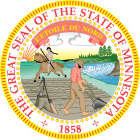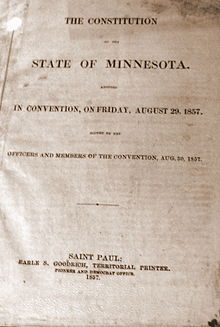- Minnesota Constitution
-
Minnesota 
This article is part of the series:
Politics and government of
MinnesotaConstitutionExecutiveLegislatureJudiciaryElectionsDivisionsFederal Relations
The Constitution of the State of Minnesota, USA was initially approved by the residents of Minnesota Territory in a special election held on October 13, 1857, and was ratified by the United States Senate on May 11, 1858, marking the admittance of Minnesota to the Union. Nearly 120 amendments have been approved (often multiple items at once), with perhaps the most significant being a reorganization in 1974 to simplify the document, making it easier for modern readers to comprehend and reducing the extensive verbiage. It is believed that the constitution was even amended twice prior to ratification.
Contents
Creation and ratification
An election in Minnesota Territory to select Republican and Democratic delegates to a state constitutional convention was held on June 1, 1857, following passage of an enabling act by the U.S. Congress on February 26 of that year ("The Enabling Act for a State of Minnesota"). The convention was held in Saint Paul from July 13 to August 29. However, the divisions between the two political parties were so great that they each held their own separate conventions and never met together aside from five people from each party who met in a conference committee to create a document acceptable to both sides. Still, the tension was so extreme that delegates would not sign anything that had previously been signed by a member of the complementary convention.
In the end, each convention signed their own copies of the document. The two were essentially identical, but had about 300 differences in punctuation, grammar, and wording because of errors in transcription produced as copyists worked late into the night on August 28. The Republican version, written on white paper, ran 39 pages and was signed by 53 delegates, while the Democratic version, written on blue-tinged paper, was 37 pages long and had 51 signatures.
On October 13, an election to approve the constitution was held. Ballots only provided for an affirmative answer, which probably reduced the number of negative votes since doing so required altering the ballot. The tally was 30,055 for acceptance and 571 for rejection.
The territorial secretary, a Democrat, sent a certified copy of the Democratic version to Washington, D.C. to be ratified by the Senate. A copy of the Republican version was also sent by an unknown party, and there is good historical evidence to show that both versions were available to Congress members. Additionally, the Republican version was sent with the bill returned to Minnesota.
The Minnesota State Legislature began to convene before the constitution was ratified, although officials elected to other positions such as governor did not begin acting in their official roles until later. The first two acts created by the legislature were amendments to the constitution, and they were approved by voters on April 15, 1858. One authorized a loan to railroads of US$5 million, and the other related to the term of office of the first state officers. Amended constitutions were apparently the ones viewed by Congress during the ratification process. The validity of the early laws passed by the Legislature is somewhat in doubt, although they have never been challenged in court.
Bill of rights
A bill of rights is featured prominently in the constitution as Article I. There are currently seventeen sections, including many that echo the amendments to the United States Constitution by subject matter, but not necessarily by language. The Minnesota Supreme Court, which has final authority over how the Bill of Rights is interpreted, has given conflicting signals about when the state Bill of Rights should be interpreted differently than the federal one.
For example, Section 3 states that "the liberty of the press shall forever remain inviolate, and all persons may freely speak, write and publish their sentiments on all subjects, being responsible for the abuse of such right." The First Amendment to the United States Constitution, by contrast, states that "Congress shall make no law ... abridging the freedom of speech, or of the press." Despite the affirmative protections of Section 3, the Minnesota Supreme Court has elected not to interpret it any differently than the First Amendment. The court's most recent case was State v. Wicklund, in 1999, which involved a failed attempted by fur-coat protesters to demonstrate at the privately owned but publicly financed Mall of America.
By contrast, Section 16 addresses the "freedom of conscience," or more generally freedom of religion. In the 1990 case of State v. Hershberger, which involved the Amish's successful attempt to be declared exempt from a state traffic law, the Minnesota Supreme Court affirmed more expansive protections for Minnesotans than the First Amendment's Free Exercise Clause provides.
Curiously, although the text of Section 10 is exactly the same as the Fourth Amendment to the United States Constitution, the Minnesota Supreme Court has frequently interpreted it differently to provide more expansive protections for persons subject to criminal prosecution under state law. For example, in the 2003 case of [1] State v. Carter, the court held that a police dog's "sniff" of a rented storage locker is a "search" under the state Bill of Rights even though it is not a search under the federal Bill of Rights. In the 1994 case of Ascher v. Commissioner of Public Safety, the court held that DWI sobriety checkpoints, while constitutional under the Fourth Amendment, were unconstitutional under Article 1, Section 10.
Some of the other provisions in the Minnesota Bill of Rights are for trial by jury and due process of law.
The Legislature
Amongst other rules, the state legislature may not meet "after the first Monday following the third Saturday in May of any year." This has the effect of halting the state government if the budget hasn't been passed by then, as happened in 2005 and again in 2011. Also, similar to the Tennessee State Constitution, bills brought before the legislature may deal with only one subject.
Transportation
Article XIV of the constitution is dedicated to discussing the public highway system of the state and the methods of funding. It authorizes a trunk highway system overseen by the state and methods of funding roadways overseen by smaller political divisions within Minnesota. Sections 4 and 5 in Article X also describe the taxation of fuel and vehicles used in relation to airborne transportation, including aircraft and supplemental vehicles.
In 1920, the Babcock Amendment authorized 70 "constitutional route" (CR) highways cris-crossing the state. Until the 1974 modification of the constitution (see section below), these were enumerated in the document itself, though today they are listed in the Minnesota Statutes (§161.114). Still, the general routes cannot be altered or removed without amending the constitution and are therefore somewhat fixed. In many cases, the constitutional route numbers do not match highway numbers. In fact, it has been common for CR highways to be composed of several different trunk highways. When the U.S. Highway system was created in 1926, many of these roads were made up of one or more U.S. highways. Today, they now use a mix of Minnesota state highways, U.S. highways, and Interstate highways.
There is some ambiguity in how literally the Minnesota Department of Transportation must interpret the constitutional routes. In some cases, the routes no longer directly serve communities they were once designated for, but are routed along nearby interstates instead.
The strong support given to automobile and aircraft transportation is often criticized by advocates of public transportation (buses, light rail, etc.), which they believe is inappropriately funded. While highways have a consistent source of money, Metro Transit has had to frequently petition the legislature for funding.
1974 alteration
In 1971, the legislature created a commission to study the constitution and make recommendations to maintain its utility. After reviewing the document for two years, it was recommended that the constitution be amended to rewrite it in modern language and allow easier reference. The amendment was approved by voters on November 5, 1974. This did not alter the meaning of the constitution, although if there is a case where meaning is ambiguous, the original document remains the final authority.
The earlier wording of the constitution, including all of the amendments approved since adoption in 1857, is printed in the Minnesota Legislative Manual 1973–74, pages 445–484.
References
- Secretary of State's Note: Minnesota State Constitution. Minnesota Secretary of State.
- Steve Riner (January 12, 2003). Legal Basis for Establishment of Minnesota Trunk Highways. The Unofficial Minnesota Highways Page.
External links
- Minnesota State Constitution on one page
- Minnesota State Constitution in multiple pages
- Amendments to Minnesota's Constitution proposed to the voters since 1858 (PDF)
- The Enabling Act for a State of Minnesota (PDF)
- Minnesota Historical Society: Minnesota's Constitution(s)
- Minnesota Statutes 161.114 Constitutional trunk highways
Constitutions of the U.S. States and Territories States Alabama · Alaska · Arizona · Arkansas · California · Colorado · Connecticut · Delaware · Florida · Georgia · Hawaii · Idaho · Illinois · Indiana · Iowa · Kansas · Kentucky · Louisiana · Maine · Maryland · Massachusetts · Michigan · Minnesota · Mississippi · Missouri · Montana · Nebraska · Nevada · New Hampshire · New Jersey · New Mexico · New York · North Carolina · North Dakota · Ohio · Oklahoma · Oregon · Pennsylvania · Rhode Island · South Carolina · South Dakota · Tennessee · Texas · Utah · Vermont · Virginia · Washington · West Virginia · Wisconsin · WyomingTerritories Categories:- Minnesota law
- State constitutions of the United States
- 1857 in law
Wikimedia Foundation. 2010.

